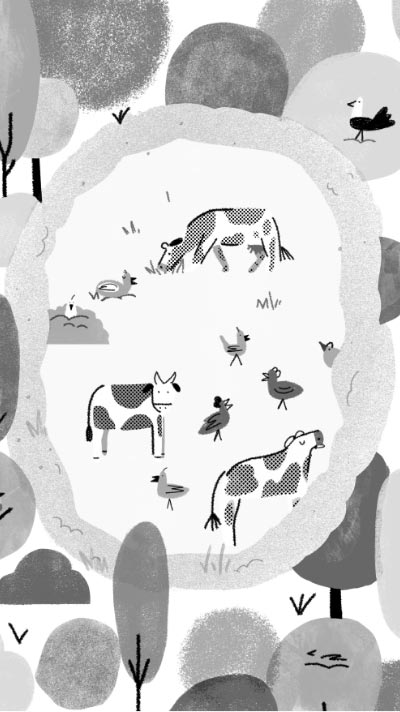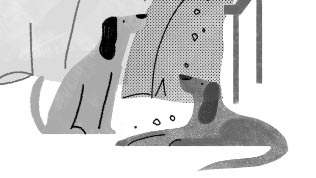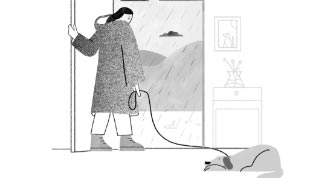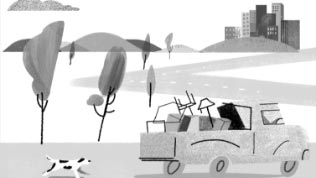Battle for the planet: Why animal welfare holds the key
By Phillip Lymbery
Protecting people means protecting animals too.
Winter in Novaya Zemlya, a Russian archipelago in the Arctic Ocean, and a snow-covered rubbish dump had been ransacked. Wooden crates were tossed aside. Cardboard, cans and plastic packaging had been scattered in search of something valuable. Anyone who came near was chased away. Local children were frightened. 'People are scared, afraid to leave the house- afraid to let their children go to school,' a local administrator said. Officials on this remote island, mainly populated by military personnel, declared a state of emergency. In decades of living here, locals had never seen anything like it. The island had been invaded by polar bears.
More than 50 polar bears were rummaging through garbage in search of food. Adults and youngsters alike jostled for what edible pickings they could find, getting into bins and entering buildings. Extra fences were erected around schools in an attempt to keep the hungry visitors out. Special patrols attempted to keep them away.
These desperate scenes played out on an island previously known for the detonation of the world's most powerful nuclear explosion. Now, with Arctic sea-ice shrinking and polar bears struggling to find food, it was witnessing the real-life consequences of something no less dramatic and more far-reaching: climate change.
Moments of anguish like this show how declines in the natural world demean animals and people alike. The hard lines of conflict between humans and animals belie the true situation, that we are all in this together; that, as nature collapses, we all stand to suffer. Nature is, after all, our life-support system, and it's slipping away.
What is becoming clearer is that the way we treat animals has a big bearing on how successful we are at addressing the twin emergencies of climate and nature collapse.
What is becoming clearer is that the way we treat animals has a big bearing on how successful we are at addressing the twin emergencies of climate and nature collapse.
Climate
'Code red for humanity' is how the UN Secretary-General described the latest scientific warnings about climate change. 'The alarm bells are deafening and the evidence is irrefutable,' said António Guterres, with the effects impacting every region on Earth, putting billions of people at immediate risk, with many changes becoming irreversible.'
Stark warnings indeed, but what does it have to do with animal welfare? Well, everything.
Drawing the link between those dump-invading polar bears and the rearing of pigs, chickens and cows for food will be critical if we are to stave off the worst effects of climate change. Food is responsible for between 21 and 37 percent of global greenhouse gas emissions. Agricultural animal production is responsible for up to 78 percent of all food-related emissions. As it is, the livestock sector produces more greenhouse gases than the direct emissions from all forms of transport.
In addition to the well-publicised problem of methane emissions from ruminants, there is another big issue - the growing of feed for factory-farmed animals, which causes climate emissions of nitrous oxide through the use of fertilisers. Nitrous oxide, the most aggressive greenhouse gas - 300 times more potent than carbon dioxide - also depletes the ozone layer. According to scientists, global nitrous oxide emissions have increased by 30 percent over the last 40 years - a period that has seen major growth in the factory farming of pigs and chickens.
Nature
As if climate change weren't bad enough, another existential threat coming at us fast is the collapse of the natural world. As nature retreats, so she stops providing essential services such as pollination, soil replenishment and carbon sequestration.
A natural world in balance with humanity is essential for a sustainable future. Wildlife declines tell us, however, that things are far from well. In the half-century since the widespread adoption of factory farming, the world has lost 68 percent of its wildlife. That's more than two-thirds of the world's wild mammals, fish, birds, reptiles and amphibians - all gone.
So, what has factory farming - the grain-feeding of confined animals - got to do with wildlife?
The truth is that factory farming is a major driver of wildlife declines worldwide. Species as diverse as elephants, jaguars and penguins are threatened as a result.
The reason for this becomes obvious when we examine the two sides of factory farming. The first side is the conditions and places in which the animals are kept. Chickens are taken from bushes and rangelands and kept in cages. Mother pigs who would naturally raise their piglets in woodland edges are kept in crates so narrow they can't turn around. Cattle are taken from pastures to be confined in mega-dairies or feedlots where they are fed grain instead of grass. All of which is often justified as a space-saving idea - only it isn't.
The other side of factory farming is the use of vast acreages of scarce arable land to grow feed crops, using chemical pesticides and fertilisers. In this industrial system, fields get bigger and, as they expand, so the trees, bushes and hedges disappear, along with wildflowers. And when they go, so too do the insects and the seeds, as well as the birds, bats and bees that depend on them. Even the worms disappear, along with soil fertility, leaving little else but the crop. Then we take that crop and feed it to incarcerated animals, where it loses much of its food value in terms of calories and protein in conversion to meat, milk and eggs.
Two-thirds of arable land globally is used to feed factory-farmed pigs, chickens and cattle, as well as to run biofuel-powered vehicles. If the crops grown worldwide for feedstuffs were placed in one field, it would cover the entire land surface of the UK and EU put together. In this way, we waste enough food to feed four billion people - half of all humanity on the planet today. Without industrial agriculture and the associated animal cruelty, we could feed everyone on less farmland, not more.
In the UK - a country renowned for being a nation of animal lovers - most animals reared for food are factory farmed. And those factory farms are getting bigger - ballooning into US-style mega-farms with upwards of 2,000 pigs or 40,000 chickens on site. According to one estimate, there are already about 800 US-style mega-farms operating across the UK.
Factory farms are hungry for arable land - an estimated 55 percent of the UK's cropland is used to grow animal feed. Just one-third of that land could provide 62 million adults a year with their five daily portions of fruit and vegetables.
And all of that has a big impact on the countryside.
In my lifetime, Britain has lost 44 million birds at the rate of a pair every minute. Birds on Britain's biggest habitat - farmland - have been particularly affected. Average populations of farmland birds have more than halved since 1970, with skylarks, starlings and lapwings among the species suffering most.
Disconnect
As a lifelong naturalist who lives on a farm, I see the impact of food production on biodiversity every single day. I am acutely aware of how cutting down forests and ripping out hedges the world over removes vital habitat for wildlife. It also reduces our ability to replenish oxygen supplies and take carbon out of the atmosphere.
As a passionate animal welfarist, I also know just how miserable life is for animals on factory farms. I remember visiting a cattle feedlot for 'battery beef' in the American Midwest. A thousand cattle stood motionless in dusty paddocks, not a blade of grass in sight. You'd have thought it would be noisy, but instead there was an eerie hush. It was like a hospital ward, the uncomfortable silence broken only by the odd cough, sneeze or wail. The stench of excrement was overpowering. Fully grown cattle and tiny calves were standing in the fierce Nebraskan summer sun with no shade, desperately trying to lie in each other's shadow.
I've visited many factory farms in Britain, too, including cage farms for egg-laying hens. I remember being overwhelmed by the sight of row after row of cages stacked on top of each other. The noise was deafening. Through the gloom, you could make out the frantic heads of hens flicking in and out of cage fronts, the only sign that they were inhabited by living creatures. They were crammed in so tightly that they couldn't stretch their wings. There were 100,000 hens locked within a mass of wire mesh, each bird with less space than a piece of standard typing paper.
Decades of campaigning brought a ban on these 'barren' cages in Britain and Europe from 2012, yet the so-called 'enriched' cages that replaced them aren't much better. They give hens a perch and a postcard-sized bit of extra space, but a cage is still a cage.
Expansionist animal welfare
What I learned from the switch to enriched cages was that genuine animal welfare will best be served by systemic change. Farm animal cruelty and the collapse of the natural world are rooted in a fundamental disconnection between humanity and nature.
As we look to transform food systems for sustainability, we will have to approach farm animal welfare differently. Rather than looking at animals in their environment and trying to work out the component parts of what they need, we should be looking to put animals back into the environment.
To me, laying hens provide the classic example of how looking at animals in their environment came up with the wrong answer. Towards the end of the last century, some of the best animal welfare scientists in the world studied hens, considering what was needed in their environment for better welfare. What did they come up with? The enriched cage: an abysmal, minimalist approach to animal welfare leading to the birds being locked in cramped confines with rudimentary clutter aimed at satisfying complex behaviours such as nesting, dustbathing and so on.
What was overlooked was that putting animals back into the environment as part of mixed, rotational, regenerative farming would provide the birds with essentials for genuinely good animal welfare naturally.
It was a salient lesson in why we need to move away from a reductionist approach to animal welfare set on modest improvements in an impoverished system.
The much more positive approach is expansionist animal welfare, where the aim is not only to accomplish freedom from suffering but also to deliver freedom to enjoy life.
Positive, expansionist approaches to animal welfare set the stage for much more healthy, humane and sustainable food systems. They offer the possibility of replacing factory farming with rearing methods that protect nature while genuinely providing for the welfare needs of sentient creatures farmed. Getting animals back out into fields as part of mixed, rotational farms is paramount. Examples of nature-friendly farming include rotational forms of pasture-fed, free-range, or organic farming. By adopting regenerative practices, we can move away from farming that incessantly draws down natural resources like soil fertility and biodiversity, instead putting resources back into nature's bank account while providing scope for the very best animal welfare.
Balance
As it stands, our world is disastrously out of balance with nature. A seminal report by Chatham House, Food system impacts on biodiversity loss, showed clearly that intensification of agriculture has not only decimated wildlife but is also affecting our ability to grow food in the future.
Essential to achieving planetary balance to protect our future, as well as the future of other species, is to produce fewer animal products. Many fewer. Diets high in meat and dairy are placing huge strain on the Earth's resources and endangering human health, with factory farming acting as the upstream driver of yet more consumption.
Taken together, the weight of humans and the animals we rear for food account for 96 percent of all mammals on Earth. Everything else, from elephants to badgers and mice, make up just 4 percent. In the avian world, domestic poultry account for 70 percent of birds by mass.
Agriculture covers nearly half the usable land surface of the planet; four-fifths of it is devoted to producing animal products. Yet meat, dairy and other animal-sourced foods contribute little more than one-third of humanity's protein needs and less than one-fifth of our calories. Whichever way you look at it, the return on investment is pitiful.
Returning to the plight of polar bears, for decades the icon of many an environmental campaign, their numbers continue to dwindle. They sit on top of the world on rapidly shrinking ice packs - as the Earth warms up, they have nowhere left to go. There are currently approximately 26,000 of them worldwide, with scientists estimating that, by the end of the century, they will be all but extinct.
Numbers of pigs and poultry, on the other hand, continue to increase, their populations running into tens of billions. And, as the burden of cropland needed to feed them expands, emissions of carbon into the atmosphere increase too.
As David Attenborough puts it, 'This is now our planet, run by humankind for humankind. There is little left for the rest of the living world'.
Common cause
In a world that's producing 80 billion land animals for food a year, most of them factory farmed, resetting the balance will require switching to welfare-positive, nature-friendly production with fewer animals.
What has become increasingly clear is that we are all in this together: farm animals, the natural world and humanity
In the battle for the planet, the key to our success will be ending factory farming and moving to more regenerative forms of farming. That will mean restoring animals to the land as part of mixed, rotational farms, while balancing our diets with more ingredients from plants and other non-animal proteins, such as cultured meat from stem cells.
The joyous thing is that when animals are returned to the land in the right way - as rotational grazers or foragers - amazing things happen. They can express their natural behaviours - running, flapping, grazing - making for happier animals with better immunity, reducing the need for veterinary antibiotics. Regenerative farming cuts reliance on chemical pesticides and fertilisers, reducing costs to farmers and creating a varied landscape bursting with wildflowers that lure back pollinating insects like bumblebees, as well as providing seeds and insects for birds and other wildlife. Rivers benefit from cleaner water, stronger riverbanks and less flooding because the soil stays in the fields when it rains, while riverbeds no longer silt up, so trout and other fish have habitats in which to spawn.
Regenerative farming also takes the pressure off the world's remaining forests, reducing the need for deforestation to make way for more arable land. In this way, trees can carry on taking carbon out of the atmosphere in return for the oxygen we breathe.
Fusion
In this growing age of planetary crisis, there is a pressing need for bigger, bolder, more urgent solutions, ones that join the dots between our predicaments, making for game-changing solutions that bring multiple benefits.
Thinking about how best to improve the welfare of animals farmed and wild, it is possible to see great potential in a fusion of welfare and environmentalism. Ending animal cruelty is both a huge ethical issue and a global imperative for a sustainable future. Embracing both together opens up a richness of beautiful, visionary solutions: landscapes bursting with life, providing healthy, nutritious food in ways that allow animals to experience the joy of life.
What will bring an end to factory farming will be growing recognition that safeguarding the future for fellow creatures - whether polar bears, pigs, chickens, or coming generations of children - relies on us truly embracing the concept that protecting people means protecting animals too.

Philip Lymbery
Philip Lymbery is the global CEO of Compassion in World Farming, visiting professor at the University of Winchester, president of Eurogroup for Animals, founding board member of the World Federation for Animals and was appointed an ambassadorial 'Champion' for the UN Food Systems Summit in 2021. Philip is an ornithologist, photographer, dedicated animal advocate and award-winning author. His critically acclaimed books, Farmageddon: The true cost of cheap meat and Dead zone: Where the wild things were, were the first mainstream books to show factory farming as a major driver of wildlife declines and at the heart of what needs to change to stave off the climate, nature and pandemic emergencies now facing humanity.



